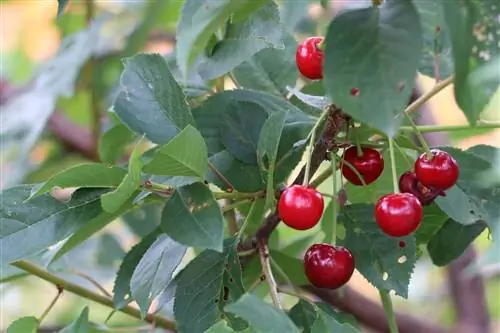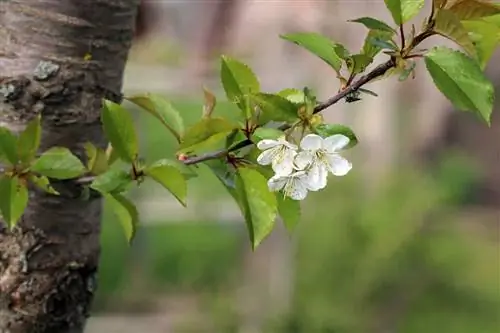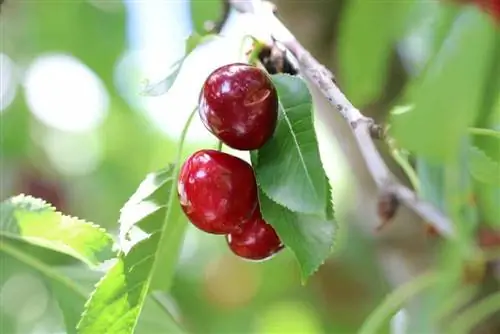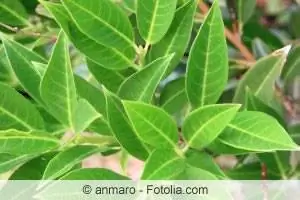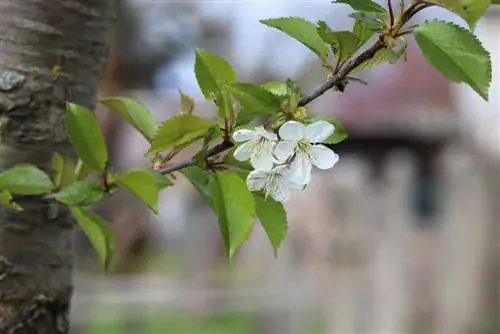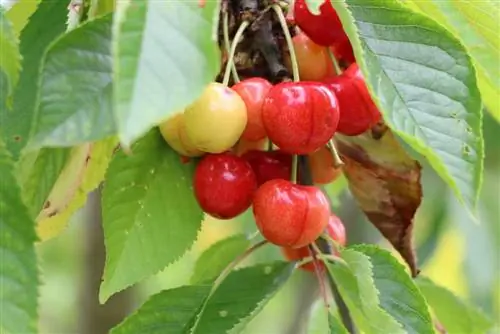- Author admin [email protected].
- Public 2023-12-17 03:39.
- Last modified 2025-01-24 12:45.
The sour cherry tree is undemanding when it comes to planting and care. Nevertheless, a few tips should be observed that will lead to the magnificent growth and a rich harvest of the morello cherry.
Location
The location is one of the most important details for he althy growth of sour cherries. It determines how well a sour cherry tree thrives and is susceptible to disease.
Light conditions
A sunny to semi-shady planting location is predominantly specified in care instructions. However, sun is very beneficial for the growth of fruits in particular, which is why it should be preferred.
Note root growth
The morello cherry develops heart-shaped root growth. This means that these lie close to the earth's surface and converge at a point at depth. A so-called root spawn can form on the surface of the earth, which can cause injuries if, for example, the lawn is cut, scarified or raked. Therefore, care should be taken to choose a location where the roots can spread freely without being exposed to the risk of injury.
Soil conditions
Ideal soil conditions are very important so that sufficient moisture and nutrients reach the roots and they can settle in the soil for good tree stability and he althy growth.
The following tips regarding the condition of the soil should be taken into account:
- Looseness and permeability
- Medium to deep
- Humus-rich
- Moderate to light humidity
- Sandy soil promotes moisture retention
- Tolerates clayey soil, but should not be too heavy due to permeability
Planting Tips
When planting, it depends on when and how it is done:
Best planting time
Although container goods can be planted all year round as long as it is frost-free, the best planting times are in autumn or spring.
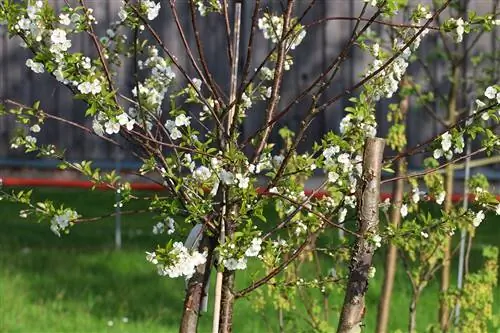
Space requirement
How much space sour cherries need depends on their size. For example, columnar forms require less space than a “wild” shrub. The following tips are for orientation:
- Planting distance: five to six by three meters
- Planting hole size: twice as deep and high as plant ball
- Bucket size: at least 30 liter capacity (for columnar cherries)
Stability
Because the roots cannot provide sufficient stability initially after planting, a stake should definitely be used for stabilization. This also serves to “relieve” the roots and protect fine root systems from tearing off. In the case of columnar growth, it is advisable to permanently attach a support post to avoid tipping over/breaking due to weight due to high fruit growth.
Ideal plant neighbors
- Sweet cherry trees for fertilization reasons,
- Woodruff, cress, chives
- Lily of the valley due to its protective effect against Monila disease
- Red foxglove for protective effect against rubber flow
Tip:
Evergreen plant neighbors have an unfavorable effect on a sour cherry tree. Therefore, you should avoid planting them close to them.
More planting tips
- On a bare-root sour cherry tree, only cover the top roots lightly with soil
- Do not place the tree deeper than in the container or previous planting location
- Always place the finishing areas above the ground surface (approx. ten centimeters)
- Enrich a third of the excavated soil with compost before filling the hole
- When filling the cherry tree, move it slightly several times so that soil gets better between the roots (promotes better grip and faster rooting)
- Soil well and water generously
- Lay a few centimeters high earth wall around the root area (to prevent water drainage)
Pouring
A sour cherry tree should never be too dry. This is especially important during the flowering period and fruit development. In addition, sour cherries burst quickly if they are not watered regularly. Therefore, the following applies: continuously monitor soil moisture and avoid drying out.
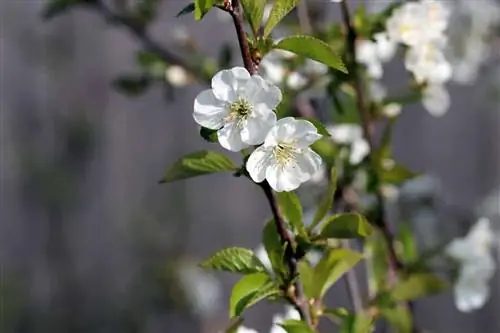
More watering tips:
- After planting, water more frequently in the first few weeks (promotes growth)
- Best watering time: early in the morning or later in the evening when there is no sun
- Mulch layer ensures less evaporation and therefore less watering effort
Fertilize
Sour cherry trees need sufficient nutrients so that they develop good resilience and grow he althily. The main focus is on four main nutrients that typically cause damage when a deficiency occurs:
Nitrogen deficiency
- Reduced height growth
- Small and yellow leaves
Potassium deficiency
Decrease in resistance and consequently increased susceptibility to illness and frostbite
Phosphorus deficiency
Delayed fruiting
Limescale deficiency
- Soil compaction
- Increased risk of waterlogging and associated root rot
- Inadequate water supply resulting in drying up and even death
Fertilization tips
Fresh mulch consisting of compost is ideal as fertilizer. Animal excretions such as horse or cow manure are also optimal sources of nutrients. Fertilization should definitely take place in spring.
Note:
Bark mulch is unsuitable for fertilization because it primarily removes nitrogen from the soil and this can result in a deficiency.
Cutting
Because the sour cherry tree tends to become bald, cutting is very important. The following tips will help you achieve magnificent growth with lots of flowers and fruits:
- Perform rejuvenation/care cuts regularly
- Best time to cut: after harvest
- Never cut in winter as there is a high risk of blood loss
- Always cut annual wood over the eye
- Short overhanging shoot branches by two thirds
- Remove crossing shoots that are too close together and dried out
- When the harvest declines or after fungal infection, extensive pruning except for two eyes
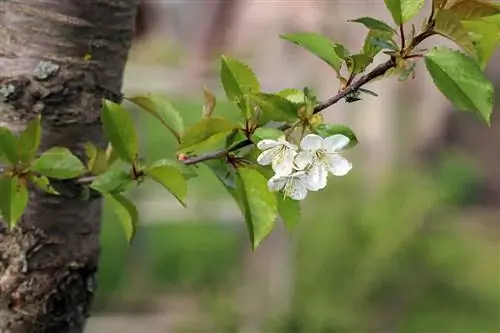
WhenNew planting Cut immediately afterwards
- Short three to four shoots (around a third/maximum to four eyes)
- Leave the middle branch longer than the shoots
- Cut off remaining shoots at base
Wintering
The sour cherry tree copes well with the cold, but should still be protected against the cold with a fleece at least in the first and second year of planting. Frost cracks can be avoided by applying a white coat of lime to at least the first quarter, preferably right up to the crown. If a morello cherry is planted in the pot, it should be placed on an insulating surface, such as a polystyrene or wooden plate.
Diseases
There are three specific diseases that are particularly common in sour cherries. There are only a few options available to prevent illness, although these do not always guarantee success. However, there are relatively effective control measures if a sour cherry tree should become ill.
Monilia Lace Drought
- Fungal Infection
- Mostly occurring during the flowering period
- Recognizable by brown blossom formation, dying flowers, dried shoots (can lead to tree death)
- First countermeasure: Cut back about 15 centimeters into the he althy wood
- Further help: Spraying pesticides: before the flowers open and during full bloom
- Prevention: Ensure good ventilation, prune in the fall to avoid open cuts in the spring
Spray spot disease
- Fungal Infection
- Identify: small, round, reddish-purple to brown leaf spots (top); Underside of leaf angular, pale red spots; Leaf yellowing, increasing leaf drop
- Mostly during warm, humid spring weather
- First aid: Safely dispose of infected and fallen leaves
- Combat: No effective method known yet: spraying nettle manure to strengthen trees often helps in the early stages
- Prevention: Spray with nettle manure every two weeks between April and June to increase resistance
Shotgun disease
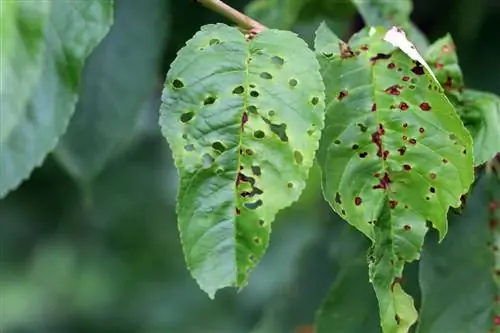
- Fungal disease
- Identify: red-brownish leaf spots, irregular leaf holes, death of affected leaves
- First aid: as described under “Spray spot disease”
- Control: Use of a fungicide during humid air conditions with repeated application after two weeks
Pests
In addition to “typical” diseases, the sour cherry tree also attracts some pests. This includes, above all, the cherry vinegar fly (Drosophila suzukii)
- Only affects fruits
- Recognize: small, puncture/hole-like fruit damage; Fruit surface has soft spots; fly maggots inside fruit; Feeding marks
- Combat: Spray of water and apple cider vinegar in equal parts plus two drops of dishwashing liquid, spray sour cherry until dripping wet every three days
- Prevention: Place a protective net over sour cherries and/or create a natural garden with natural predators

